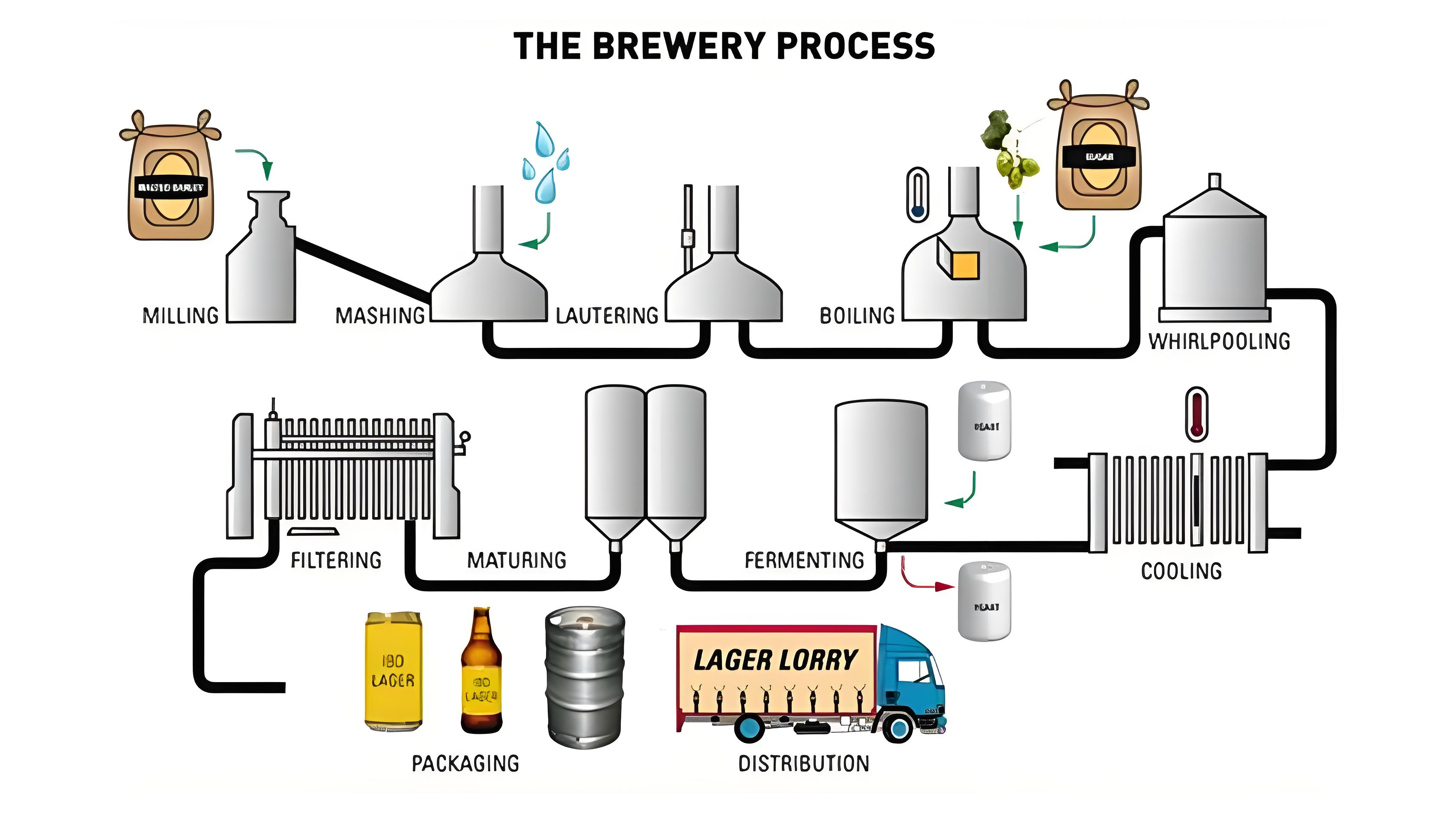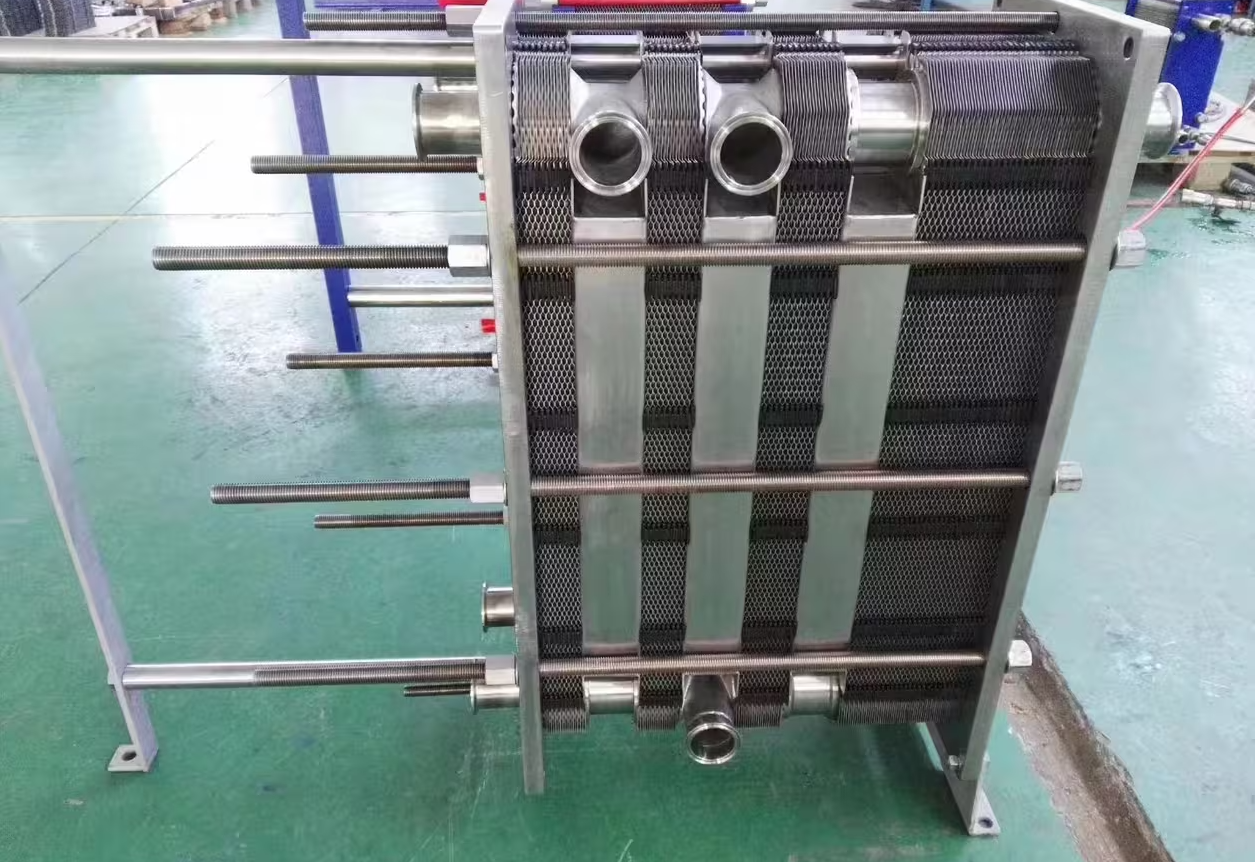Application of KDP Plate Heat Exchanger in the Industrial Process of Beer Brewing
Application of KDP Plate Heat Exchanger in the Industrial Process of Beer Brewing
The key steps in beer brewing include wort preparation, fermentation, pasteurization, and filling, with plate heat exchangers playing a central role in the following processes:

Cooling of wort
The boiled wort needs to be rapidly cooled from 95-98 ℃ to 6-8 ℃ (fermentation temperature) to prevent microbial contamination and promote yeast activity. Plate heat exchangers use counter current heat exchange to efficiently exchange heat between cold water or refrigerant (such as ethylene glycol) and hot wort.
Pasteurization
Pasteurize the beer before filling, heat it to 72-75 ℃ (maintained for 15-30 seconds) using a plate heat exchanger, and then quickly cool it to the filling temperature. This process can kill microorganisms and extend shelf life.
Heat recovery and preheating
Utilize the residual heat of cooling wort to preheat brewing water, such as heating cold water from 15 ℃ to 80 ℃, significantly reducing energy consumption by 45%. This process is achieved through multi-stage plate heat exchangers to improve energy utilization efficiency.
Fermentation mash cooling
Temperature control is required during the fermentation process to maintain yeast activity. Plate heat exchangers can accurately adjust the temperature of the mash, replacing traditional spray cooling systems, reducing water consumption and avoiding blockages.
The core advantages of KDP plate heat exchangers in beer brewing
Efficient heat transfer and energy conservation
Turbulent design:
The corrugated plates create turbulence, resulting in a heat transfer efficiency 3-5 times that of shell and tube heat exchangers, and a cooling time reduction of 4-6 times.
Waste heat recovery:
By preheating cold water to achieve thermal energy recycling, energy consumption is reduced by more than 30%.
Compact structure and flexibility
Small footprint:
With the same heat transfer capacity, the volume is only one-third of that of a shell and tube type, making it suitable for workshops with limited space.
Modular expansion:
By increasing or decreasing the number of boards, the processing capacity can be flexibly adjusted to adapt to different production scales.
Hygiene and ease of maintenance
Food grade materials:
Made of stainless steel plates and non adhesive sealing gaskets, in compliance with food safety standards, corrosion-resistant and easy to clean.
Quick disassembly and cleaning:
The board is designed to be detachable for thorough cleaning, avoiding blockages caused by condensed solids or hop residue.
Precise temperature control and safety
Temperature stability:
The temperature fluctuation at the wort outlet is controlled within ± 0.5 ℃ to ensure fermentation quality.
Double sealed leakage prevention:
The design of dual sealing gaskets between the plates prevents cross contamination between the refrigerant and wort.
Adapt to complex media
Wide channel design:
Some models can handle media containing particles or high viscosity (such as malt extract) to avoid blockage.
Application cases of KDP plate heat exchangers and gaskets in the field of beer brewing
Case background:
A medium-sized craft brewery is facing problems such as low cooling efficiency, high maintenance costs, and uneven wort cooling of traditional shell and tube heat exchangers when expanding production scale. To improve quality and efficiency, the factory has introduced wide channel plate heat exchangers (equipped with food grade EPDM gaskets) for use in wort cooling and heat recovery processes.

Equipment selection and design features
Selection of Plate Heat Exchanger
Adopting the wide channel plate heat exchanger produced by KDP, the plate spacing is expanded to 6-8mm to avoid blockage of the flow channel by particles such as hop residue and condensed solids in malt extract.
The plate is made of 316L stainless steel, and the rubber pad is made of high temperature resistant (-20~150 ℃) and corrosion-resistant EPDM material, which meets FDA standards and ensures no risk of contamination.
Rubber gasket sealing design
The rubber pad adopts a double channel groove design to prevent cross leakage of wort and cooling medium (ethylene glycol solution), while withstanding a pressure difference of 0.4MPa.
Rubber pad snap on installation, no special tools required, single maintenance time reduced to less than 30 minutes.
Application process and key operations
Cooling process of wort
Use 85 ℃ hot water to circulate and rinse the wort side and pipelines of the heat exchanger for 30 minutes to kill residual microorganisms.
Boiled 98 ℃ wort is subjected to counter current heat exchange with a 4 ℃ ethylene glycol solution, and the outlet temperature is stabilized at 8 ± 0.5 ℃. The cooling time is shortened to 40 minutes (traditional equipment requires 2 hours).
The heat absorbed by the refrigerant is preheated into brewing water (15 ℃ → 75 ℃) through a secondary heat exchanger, achieving an energy-saving rate of 35%.
Rubber pad maintenance and fault prevention
After each batch of production, check the compression status of the rubber gasket. If any deformation or aging is found, replace it immediately to avoid seal failure.
Using CIP (In Situ Cleaning) system, the surface of the plate and adhesive pad are cleaned by circulating 1% NaOH solution to remove protein and hop resin residue.
Comparison of application effectiveness and advantages
Case conclusion
By introducing wide channel plate heat exchangers and high-performance rubber pads, the brewery has achieved:
Production efficiency improvement
The cooling efficiency of wort has increased by 200%, and the annual production capacity has increased from 10000 tons to 25000 tons.
Quality stability
The temperature fluctuation of wort is ≤ 0.5 ℃, and the fermentation consistency is significantly improved.
Comprehensive cost reduction
Energy consumption and maintenance costs have been reduced by 40%, and the investment payback period has been shortened to 1.5 years.
This case confirms the core value of plate heat exchangers and rubber pads in beer brewing, and their high efficiency, flexibility, and hygiene characteristics have become the benchmark solution for upgrading the modern beer industry.

King DuPont, China famous brand of heat transfer and fluid handling supply platform.
Contact

Get Free Quotes
NEED TO CHAT?
We will get back to you within 24 hours of receiving the message.

